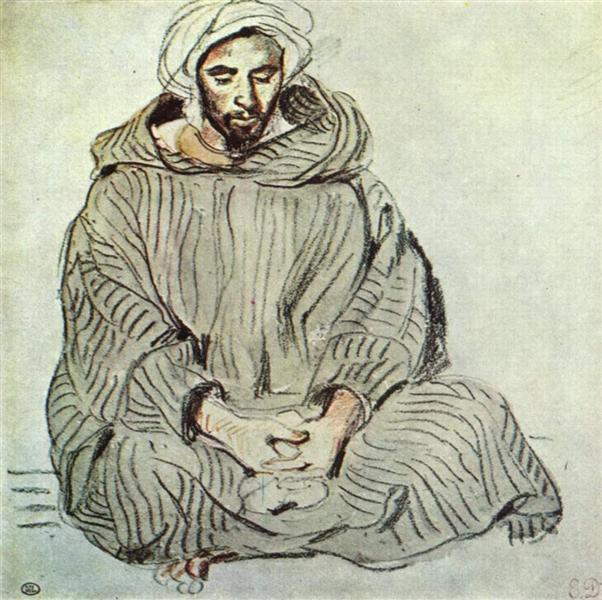Description
Eugène Delacroix's "Seated Arab in Tangier", painted in 1832, is one of the most eloquent manifestations of the Orientalism that characterized much of 19th-century European art. This style, which went beyond the simple representation of Asian or African subjects, sought to capture the essence of cultures considered exotic or alien, mixing fascination with a certain idealization. Delacroix, a master of Romanticism, embarked on a trip to Morocco in 1832 that profoundly influenced his work, providing not only a focus on the picturesque but also a bold use of color and form.
In “Arab Seated in Tangier,” the viewer is greeted by a central figure who conveys both dignity and intimacy. The Arab, who sits with a relaxed but confident posture, is dressed in traditional clothing that captures a rich and varied palette. The predominant hues of his clothing, including deep blues and vibrant reds, are masterfully complemented by the more earthy, neutral background tones, such as beige and brown, which evoke the warmth of the Moroccan environment. This contrast highlights the figure of the Arab, while providing a context that suggests not only the geography, but also the cultural atmosphere of the region.
The man’s expression is contemplative; his gaze seems directed at a distant point, which adds an air of mystery and depth to the work. This portrait does not seek to break down his character into an explicit cultural or racial label; instead, Delacroix captures a universal humanity that transcends the barriers of stereotypical representation. This choice of representation reveals the artist’s interest in the subjectivity of his models, seeking to humanize and dignify the Arab subject in a period when Western art often tended to reproduce simplistic and colonial images.
Delacroix's mastery lies not only in his ability to render the human figure with great truth and movement, but also in his ability to manipulate light and colour in a way that brings his work to life. The texture of the clothing and the quality of the light that seems to bathe it give the painting an almost palpable feel. This attention to detail aligns with the technique of chiaroscuro, where shadows and light are skillfully used to create volume and depth, a hallmark of the artist's work.
It is also worth noting that "Seated Arab in Tangier" is part of a series of works that Delacroix dedicated to the representation of the Arab world after his trip to Morocco, a theme that he had begun to explore through the painting of landscapes and scenes of daily life in the region. This connection with Arab culture, far from being a mere romantic whim, becomes a dialogue that invites a deeper reflection on the cultural relations between East and West.
The legacy of “Seated Arab in Tangier” lies not only in its aesthetic beauty, but in its ability to raise questions about identity, representation and history. A seated figure in a characteristic Tangier setting, whose very presence on the canvas challenges the dominant and stereotypical narratives of its time, proves to be a powerful reminder of art’s potential as a vehicle for empathy and mutual understanding. Delacroix, with his particular romantic vision and passionate approach, offers a window into a rich and multifaceted culture, inviting the viewer to look beyond conventions and celebrate the diversity of the human experience.
KUADROS ©, a famous painting on your wall.
Hand-made oil painting reproductions, with the quality of professional artists and the distinctive seal of KUADROS ©.
Painting reproduction service with satisfaction guarantee. If you are not completely satisfied with the replica of your painting, we will refund 100% of your money.

